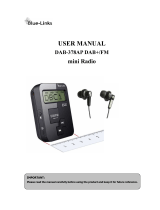
Controls .......................................................................2-3
Battery operation using alkaline batteries.......................4
Battery operation using rechargeable batteries ..............5
Using the AC adaptor .....................................................6
Operating your radio - DAB ............................................7
Selecting a station - DAB................................................8
Display options - DAB.....................................................9
Finding new stations - DAB ..........................................10
Secondary services - DAB............................................10
Manual tuning - DAB .................................................... 11
Signal strength display - DAB ....................................... 11
Dynamic range control (DRC) settings - DAB ..............12
Prune stations - DAB ....................................................13
Operating your radio - Search tuning - FM ...................14
Manual tuning - FM.......................................................15
Display options - FM .....................................................16
Favourite button............................................................17
Recalling your favourite station ....................................17
Preset stations - DAB and FM ......................................18
Scan sensitivity - FM ....................................................19
Contents
Stereo / mono setting - FM (Headphones only)............20
Software version ...........................................................20
System reset.................................................................21
Headphone socket........................................................22
Auxiliary input socket ....................................................22
A few words about batteries ....................................23-24
Display backlight...........................................................25
General ......................................................................... 26
Specifi cations ...............................................................26
Circuit features .............................................................26
Guarantee........................................................Back page
1




















